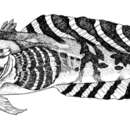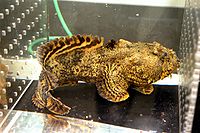mk
имиња во трошки


The oyster toadfish, Opsanus tau, also known as the ugly toad, oyster cracker and "bar dog", is a toadfish native to the western Atlantic in shallow waters between Massachusetts and Florida. A tadpole-shaped bottom dweller with a large mouth, its cryptic coloration make it well camouflaged in crevices on rocky/sandy/muddy substrates and reefs, jettys or wrecks from which the oyster toadfish ambushes its prey of a diverse range of fish and invertebrates. Like most toadfishes (family Batrachoididae), males of this species are known for attracting females to a nest by generating a deep grunting sound by vibrating their swimbladder. Oyster toadfish are hearty fish, able to withstand being out of water for up to 24 hours, and can live in polluted waters. They commonly grow to about 30 cms. While edible, they are not commonly eaten, perhaps because of their grotesque appearance.
Opsanus tau has been used as a lab research animal to investigate such topics as muscular contraction (the muscles wiring its swimbladder twitch faster than any other known vertebrate muscle), diabetes, drug metabolism and toxicology. The species is also a valuable neurological model for vestibular system disorders, including balance disruption, dizziness, and motion sickness; this research involved sending two fish into space on shuttle mission STS-95 in 1998 to examine the effect of gravity on the vestibular system, a topic important to astronauts. The oyster toadfish’s species name, tau, derives from the shape of one of the fish’s vestibular canals which resembles the Greek letter tau.
(Marine Biological Laboratory Labnotes 1997; Wikipedia 2012; Woods Hole National Oceanographic Institute)
The oyster toadfish, Opsanus tau, also known as the oyster toad, ugly toad, oyster cracker, oyster catcher, and bar dog, is a Northeast Atlantic species of fish of the family Batrachoididae. The maximum length of this toadfish is 43.2 cm (17 in), but they infrequently surpass 38 cm (15 in). The world record size for this species is 19.2 inches which is 48.76 cm. They are generally yellowish with a pattern of brown oblique bars. The species can live in poor conditions and needs little food to live. They can be found near the shore from Maine to Florida.
In 1998, NASA sent the oyster toadfish into space to investigate the effects of microgravity on the development of otolithic organs. The study found little difference between terrestrial development and those in space.
Oyster toadfish spawn in coastal estuaries from May through August, with some variation between latitudes.[3] Males excavate nests under rocks or other debris and begin making advertisement calls, also known as boatwhistles and foghorns. Females are attracted to these calls. Females choose a mate, enter the nest, attach eggs to the underside of the structure, then leave. Females provide no parental care. Males fertilize the eggs, then defend and clean the nest while embryos develop. Toadfish embryos are large and, as a result, have been studied for over a century.[4]
After about 4 weeks the eggs hatch. At first, the young toadfish stay attached to the yolk. When the yolk has been absorbed for energy, the young toadfish learn to swim. Even when the young have started to swim, the adult still protects its young.
Juveniles reach sexual maturity by year 2 and have a lifespan of 8 years.[5] Little is known about individual range or whether toadfish exhibit natal philopatry.
Toadfish are ambush predators during the day, when they remain buried or hidden under structure and lunge for passing prey. At night they forage. Toadfish eat benthic invertebrates (e.g. polychaetes) and xanthid crabs.[6] Toadfish have sharp teeth and powerful jaws.
Oyster toadfish are apex predators on oyster reefs. Nonetheless, evidence exists that they are prey for birds (e.g. cormorants[7]). A related species, Opsanus beta, is prey for dolphins.[8] Research has demonstrated that toadfish will call less when dolphin sounds are played from a nearby speaker.[9] For protection, toadfish have a venomous spine in the first ray of the dorsal fin. They can bury themselves up to their eyeballs in sand, and might be capable of camouflage.
Like many bony fish oyster toadfish have a swim bladder that is used to maintain buoyancy. Like some vocalizing fish, the swim bladder is also used to make sounds. Oyster toadfish males use their swimbladders to make advertisement calls. The fast-twitch swimbladder muscles of toadfish can contract as much as 300 times per second,[10] more quickly than fast-twitch muscles in most vertebrates.
Toadfish are easy to observe and collect because they spawn in shallow water. Also, male advertisement calls are easy to detect and are critical for the animal's reproductive success. For these reasons, toadfish have been widely studied in research that examines mating behavior, hearing sensitivity[11] and the impacts of anthropogenic noise.
Oyster toadfish are called "trash fish" amongst some fishermen due to their hungry nature and hard to fillet bonny bodies. The meat of the oyster toadfish is very flaky and is told to have a sweet flavor. Fishermen also say they have similar flavors to blowfish.[12] It is also safe to eat raw like sashimi or ceviche.
{{cite web}}: External link in |last=The oyster toadfish, Opsanus tau, also known as the oyster toad, ugly toad, oyster cracker, oyster catcher, and bar dog, is a Northeast Atlantic species of fish of the family Batrachoididae. The maximum length of this toadfish is 43.2 cm (17 in), but they infrequently surpass 38 cm (15 in). The world record size for this species is 19.2 inches which is 48.76 cm. They are generally yellowish with a pattern of brown oblique bars. The species can live in poor conditions and needs little food to live. They can be found near the shore from Maine to Florida.
 Oyster toadfish
Oyster toadfish In 1998, NASA sent the oyster toadfish into space to investigate the effects of microgravity on the development of otolithic organs. The study found little difference between terrestrial development and those in space.
Opsanus tau Opsanus generoko animalia da. Arrainen barruko Actinopterygii klasean sailkatzen da, Batrachoididae familian.
Opsanus tau Opsanus generoko animalia da. Arrainen barruko Actinopterygii klasean sailkatzen da, Batrachoididae familian.
Opsanus tau is een straalvinnige vissensoort uit de familie van kikvorsvissen (Batrachoididae).[1] De wetenschappelijke naam van de soort is voor het eerst geldig gepubliceerd in 1766 door Linnaeus.
Bronnen, noten en/of referentiesTau[3] (Opsanus tau) – gatunek morskiej ryby batrachokształtnej z rodziny batrachowatych (Batrachoididae). Ze względu na osiągane rozmiary i dużą odporność na czynniki środowiskowe nabrał znaczenia jako ryba eksperymentalna wykorzystywana w różnorodnych badaniach. Współwystępuje z pokrewnym ropusznikiem beta[4]. Obydwa gatunki mają podobną budowę i zachowania.
Północno-zachodnie wody Oceanu Atlantyckiego od wybrzeży stanu Maine (USA) do Kuby.
Głowa duża i płaska. Zaokrąglony pysk zakończony jest dużym otworem gębowym. Płetwy piersiowe bardzo duże. Tau osiąga maksymalnie 43 cm długości i około 2,2 kg masy ciała[5]. Na pokrywach skrzelowych, wokół oczu i otworu gębowego ma liczne frędzlowate wyrostki. Przed płetwą grzbietową ma 3 mocne kolce i kolec na pokrywie skrzelowej. Ubarwienie zmienne, zazwyczaj żółtawo-brązowe, ciemniejsze na grzbiecie i bokach ciała.
Tau występuje w wodach przybrzeżnych nad dnem skalistym i wśród raf, żyje wśród zarośli trawy morskiej. Spotykany jest w pirsach i wrakach[5]. Toleruje zanieczyszczone wody.
Jest to gatunek wszystkożerny i żarłoczny. Mało ruchliwy. Poluje na drobne skorupiaki i ryby, z zaskoczenia, stosując kamuflaż wśród elementów dna. Samice składają ikrę pod kamieniami lub do pustych muszli. Samiec strzeże jej przez 3 tygodnie.
W literaturze został rozpowszechniony z powodu wydawanych dźwięków, znacznie różniących się od dźwięków wydawanych przez inne gatunki ryb. W okresie godowym samce oraz samice Opsanus tau emitują krótkie, pojedyncze lub seryjne dźwięki. Samce opiekujące się potomstwem wydają długie donośne ryki. Dźwięki wydawane przez tau powstają w efekcie bardzo szybkich wibracji pęcherza pławnego, wywołanych skurczami mięśnia poprzecznie prążkowanego[3][6][7].
Ryba jest często odławiana jako ciekawostka do akwariów publicznych. Ma również lokalne znaczenie gastronomiczne.
Kilka osobników tau uczestniczyło w lotach STS-90 i STS-95, w czasie których prowadzono na nich badania nad wpływem mikrograwitacji na układ przedsionkowy i zmysł równowagi[8].
Tau (Opsanus tau) – gatunek morskiej ryby batrachokształtnej z rodziny batrachowatych (Batrachoididae). Ze względu na osiągane rozmiary i dużą odporność na czynniki środowiskowe nabrał znaczenia jako ryba eksperymentalna wykorzystywana w różnorodnych badaniach. Współwystępuje z pokrewnym ropusznikiem beta. Obydwa gatunki mają podobną budowę i zachowania.
Ostronpaddfisk (Opsanus tau L.) är en saltvattenfisk som lever i västra Atlanten vid USA:s östkust. Den största uppmätta längden på ett vildfångat exemplar är 43,2 centimeter. Fisken har odlats i fångenskap.[1]
Arten är bland annat känd för att fyra exemplar, tillsammans med 229 stycken svärdbärare, medfördes ombord på Spacelab i rymdfärjan Columbia, den 17 april 1998. Fiskarna tjänade som forskningsobjekt i uppdraget STS-90, och man valde just ostronpaddfisken på grund av dess stora härdighet. Målet med undersökningen var att studera hur fiskarnas hjärnor och centrala nervsystem påverkades av den låga gravitationen i omloppsbanor nära jorden.[2]
Ostronpaddfisk (Opsanus tau L.) är en saltvattenfisk som lever i västra Atlanten vid USA:s östkust. Den största uppmätta längden på ett vildfångat exemplar är 43,2 centimeter. Fisken har odlats i fångenskap.
Arten är bland annat känd för att fyra exemplar, tillsammans med 229 stycken svärdbärare, medfördes ombord på Spacelab i rymdfärjan Columbia, den 17 april 1998. Fiskarna tjänade som forskningsobjekt i uppdraget STS-90, och man valde just ostronpaddfisken på grund av dess stora härdighet. Målet med undersökningen var att studera hur fiskarnas hjärnor och centrala nervsystem påverkades av den låga gravitationen i omloppsbanor nära jorden.
Opsanus tau (Linnaeus, 1766)
Охранный статусРыба-жаба[1] (лат. Opsanus tau) — вид рыб семейства батраховых, или рыб-жаб (Batrachoididae) отряда батрахообразных (Batrachoidiformes).
Встречается в западной части Атлантического океана от полуострова Кейп-Код до Флориды на илистом или песчаном дне, иногда зарываясь в него по самые глаза.
Охотится на мелкую рыбу, крабов, моллюсков, червей, неподвижно подстерегая добычу.
Голова большая, приплюснутая, с большим ртом. Максимальная длина тела 43,2 см, масса — до 2,2 кг [2].
Обладает ядовитыми шипами и представляет опасность для купальщиков.
Способна издавать звуки, имеющие характер скрежета, хриплого ворчания или гудка. Звуки издаются для предупреждения о том, что данный участок дна занят. Непосредственно вблизи рыбы эти гудки иногда имеют силу свыше 100 децибел, достигая болезненной для уха интенсивности.
Рыба-жаба (лат. Opsanus tau) — вид рыб семейства батраховых, или рыб-жаб (Batrachoididae) отряда батрахообразных (Batrachoidiformes).
Встречается в западной части Атлантического океана от полуострова Кейп-Код до Флориды на илистом или песчаном дне, иногда зарываясь в него по самые глаза.
Охотится на мелкую рыбу, крабов, моллюсков, червей, неподвижно подстерегая добычу.
Голова большая, приплюснутая, с большим ртом. Максимальная длина тела 43,2 см, масса — до 2,2 кг .
Обладает ядовитыми шипами и представляет опасность для купальщиков.
Способна издавать звуки, имеющие характер скрежета, хриплого ворчания или гудка. Звуки издаются для предупреждения о том, что данный участок дна занят. Непосредственно вблизи рыбы эти гудки иногда имеют силу свыше 100 децибел, достигая болезненной для уха интенсивности.
毒棘豹蟾魚(英文:Oyster Toadfish;學名:Opsanus tau),蟾魚科豹蟾魚屬,主要分布於西太平洋、美國麻薩諸塞州至佛羅里達州等地,體長可達43.2公分,棲息在主要生活在礁石區,能在條件很差之環境下生存,只需有些許之食物即能存活,具毒性,可作為觀賞魚。1997年,美國宇航局以哥倫比亞號太空梭帶了一條毒棘豹蟾魚上太空,以研究微重力效應。
毒棘豹蟾魚(英文:Oyster Toadfish;學名:Opsanus tau),蟾魚科豹蟾魚屬,主要分布於西太平洋、美國麻薩諸塞州至佛羅里達州等地,體長可達43.2公分,棲息在主要生活在礁石區,能在條件很差之環境下生存,只需有些許之食物即能存活,具毒性,可作為觀賞魚。1997年,美國宇航局以哥倫比亞號太空梭帶了一條毒棘豹蟾魚上太空,以研究微重力效應。